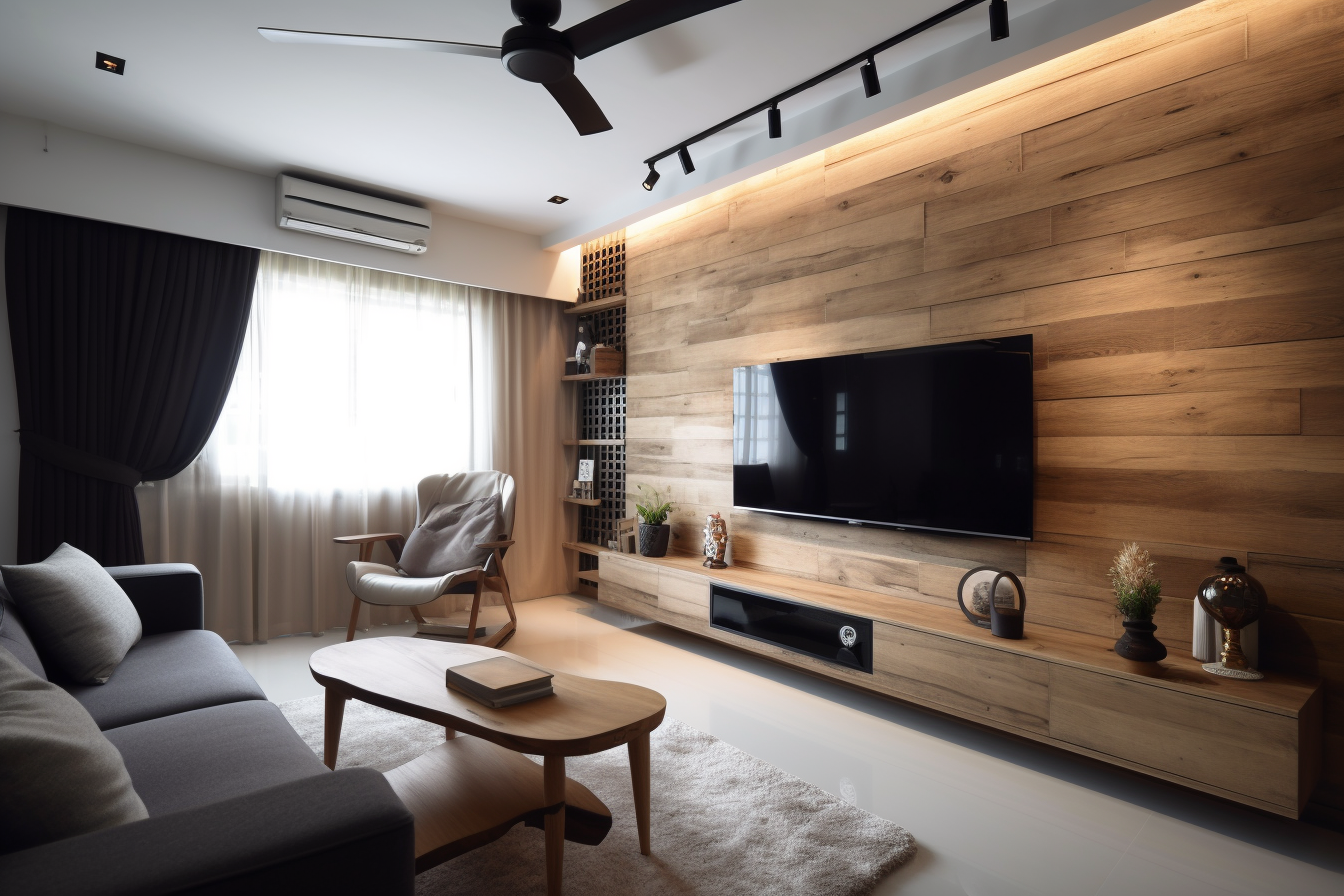Ceiling fans often evoke mixed feelings – some view them as outdated and bulky, while others appreciate their effectiveness and energy efficiency in ventilating a space. Moreover, they’re considered kid and pet-friendly, eliminating concerns about accidents with fingers or fur getting caught in the blades.
Determining whether to incorporate ceiling fans into your Singaporean home involves weighing several factors, encompassing functionality, Feng Shui principles, and climatic considerations. Here’s a comprehensive guide to aid your decision-making process:
Singapore’s Climate and Comfort
Given Singapore’s tropical climate characterized by high humidity and temperatures, ceiling fans emerge as a practical solution for providing cooling and air circulation. They effectively mitigate the heat and humidity, particularly during sweltering months, offering relief without solely relying on air conditioning.
Firstly, the size of the fan matters. Larger rooms necessitate fans with wider blades to ensure adequate cooling. HDB regulations also restrict ceiling fans to a maximum weight of 35kg. Additionally, the height of your ceiling is crucial for efficient fan operation and safety. HDB mandates a minimum clearance height of 2.4m from the floor.
Energy Efficiency
Ceiling fans boast superior energy efficiency compared to air conditioners, rendering them a cost-effective cooling option for your home. When used in conjunction with air conditioning, they facilitate reduced energy consumption and decreased electricity bills. Strategic placement of fans can optimize airflow and enhance the distribution of cooled air.
Many ceiling fans offer the option to integrate lights, either built-in or as an accessory. Opting for LED bulbs enhances energy efficiency. Speaking of energy efficiency, fans with DC motors consume significantly less energy compared to those with AC motors, making them a worthwhile investment despite the higher initial cost.
Ensuring that your ceiling fan bears a Safety Mark is crucial for compliance with Singaporean safety standards. Purchasing from reputable local retailers is recommended to avoid potential safety hazards associated with overseas purchases.
Room Size and Layout
Assess the dimensions and arrangement of each room to determine the suitability of ceiling fan installation. Larger spaces with expansive floor areas or lofty ceilings stand to benefit from ceiling fans, which enhance air circulation and uphold a comfortable indoor environment. Additionally, areas lacking adequate ventilation, such as kitchens, bathrooms, or enclosed spaces, can profit from ceiling fans to avert stagnant air and moisture accumulation.
When it comes to selecting ceiling fans for different room sizes, it’s essential to consider the basic principles of physics. Larger rooms naturally require fans with wider blades to effectively circulate air and maintain a comfortable temperature. Typically, ceiling fans with blade lengths ranging from 55 to 60 inches are suitable for larger rooms, ensuring optimal airflow and cooling.
Conversely, smaller rooms can suffice with fans featuring blade lengths between 44 to 56 inches, providing sufficient air circulation without overwhelming the space. It’s important to note that regardless of the room size, HDB regulations mandate that ceiling fans must not exceed a maximum weight of 35kg, ensuring safety and compliance with building standards.
Feng Shui Considerations
In Feng Shui philosophy, ceiling fans are believed to foster airflow and energy circulation, fostering a harmonious ambiance. However, mindful placement is essential to prevent disruptive energy or discomfort. Avoid positioning ceiling fans directly above beds or seating areas, favoring central locations or areas conducive to airflow enhancement.
CWhile some believe ceiling fans disrupt sleep and harbor negative energy, others argue they promote healthy Chi circulation and cooling. Proper placement is crucial, avoiding direct positioning above resting areas like sofas, dining tables, or beds. Ceiling fans should hang at an appropriate height to avoid creating pressure and discomfort.
Non-adjustable built-in lights can affect Feng Shui negatively, but adjustable lighting can mitigate this. Opting for neutral-colored fans can enhance relaxation and promote a positive ambiance. Regular assessment ensures that ceiling fans contribute positively to home Feng Shui, promoting relaxation and comfort.
Aesthetic Harmony and Design Cohesion
When it comes to design, ceiling fans come in various styles, so it’s essential to choose one that complements your flat’s decor. Opting for a sleek design can prevent a bulky fan from creating the illusion of a lower ceiling. Factor in your home’s aesthetic preferences and design motifs when selecting ceiling fans.
Opt for models that seamlessly integrate with your interior decor, whether it leans towards sleek modernism or traditional elegance. Choose fan blades, finishes, and accessories that complement your design scheme, enhancing the visual appeal of your living spaces.
Noise Level Consideration
Be mindful of the noise output of ceiling fans, particularly if they are destined for bedrooms or tranquil zones. Opt for models equipped with quiet motors and smooth operation to ensure a serene and undisturbed environment conducive to relaxation and restfulness.
On Choosing the Right Ceiling Fan
The performance of ceiling fans is influenced by various factors beyond just the number of blades, such as blade pitch, aerodynamics, and motor performance. The Fan Performance Indicator (FPI) is a useful tool for evaluating ceiling fan models based on personal preferences and requirements. Effective air circulation is crucial for maximizing a fan’s cooling effect within a room, ensuring an even distribution of airflow.
Factors like fan proximity to walls or obstructions can affect performance, especially in outdoor settings lacking walls for air recirculation. Selecting the right size ceiling fan for a space is essential, with recommendations based on room dimensions to ensure optimal cooling. Proper fan height placement is also critical for efficient airflow, with considerations for downrod length and ceiling slope.
Choosing between AC and DC motors is another important decision, with DC motors offering energy efficiency and additional features like remote control operation. Ceiling fan design and color options have evolved to complement various interior styles, with considerations for blade number and aesthetics. Incorporating lighting into ceiling fans adds functionality, with LED technology providing energy-efficient illumination and customizable options for brightness and color temperature.
By deliberating upon these factors encompassing functionality, Feng Shui principles, and climatic conditions, you can ascertain the suitability of ceiling fans for your Singaporean home and determine optimal placement to maximize their benefits.







